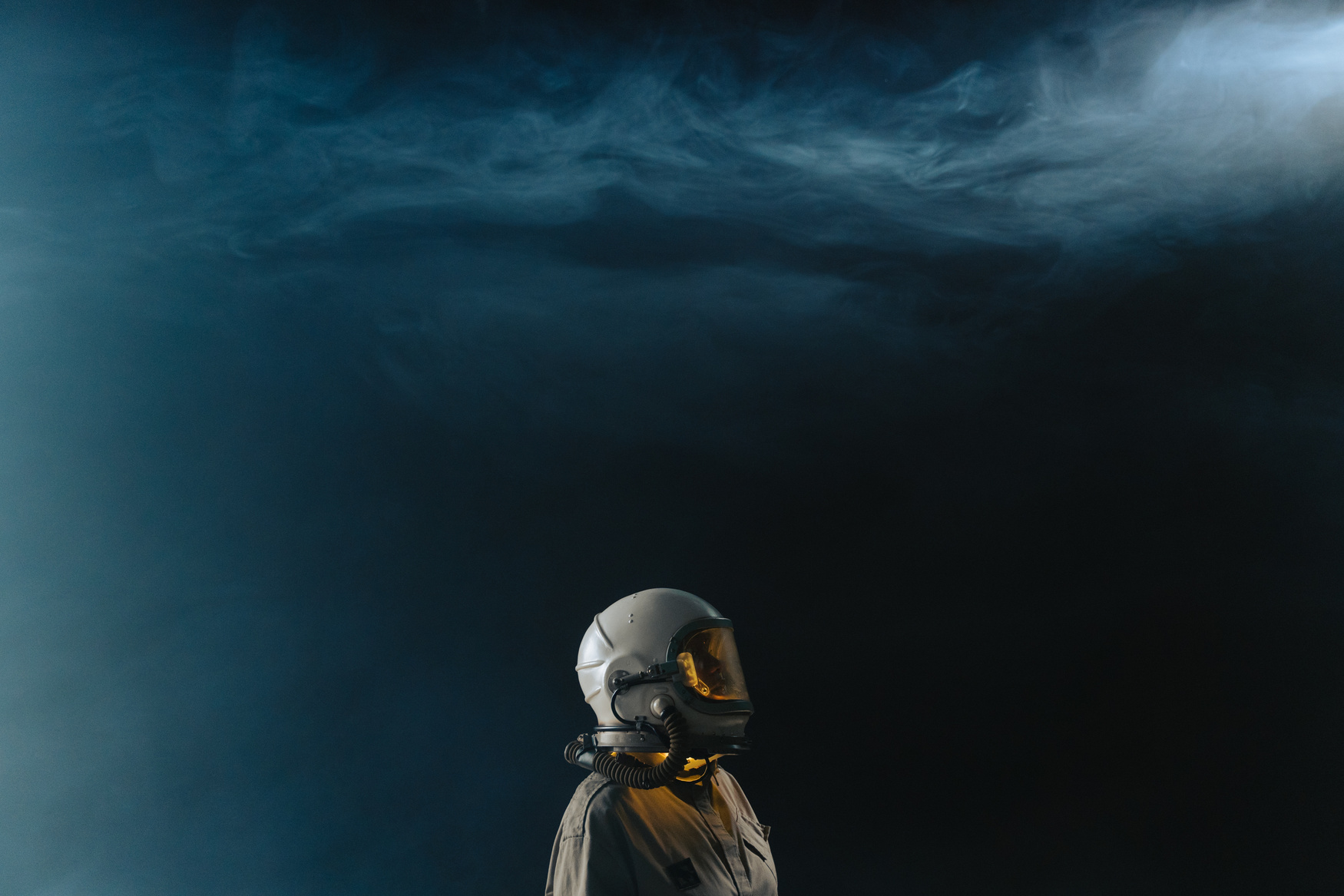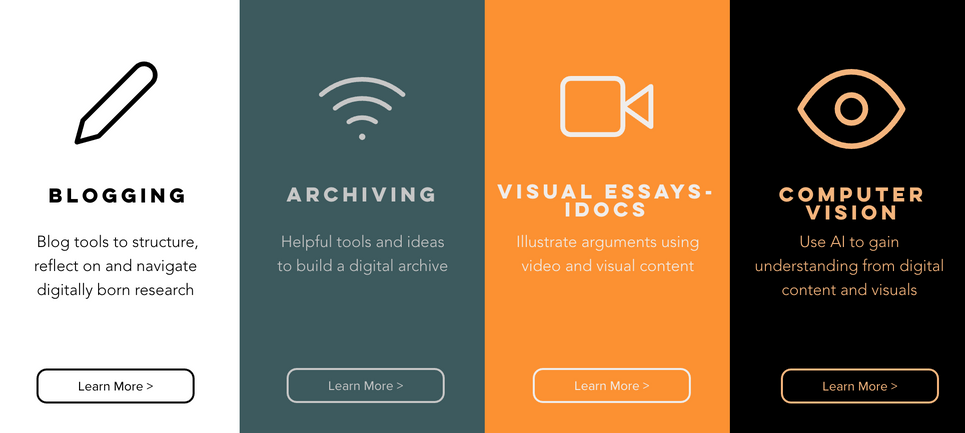Digital humanities & image scholarship
OER

Humanities in the Digital
Postdigital Selves
Thinking Images
+ Doing
Digital HUmanities (A toolkit)


Introduction
This is an open educational resource for visual and media studies scholars who have been exposed to theoretical ideas in their studies, but often lack digital (humanities) skills. The aim is to provide an overview of digital discourses and practices by immersing students in three themes with practical outputs.
The goal is not technical mastery, but learning enough about technology to think about, and through, their concepts and to discover which tools might be useful for future research. Experimenting with different digitisation and visualisation techniques allows for a fresh look and understanding of research.
Thus this is an education resource to assist and guide students at the intersection between their theoretical research and integrating into the (post)digital society.
We provide a guide for:
- developing digital skills to undertake digitally born research
- thinking critically about the current state of digital technologies in society
- navigating a postgraduate career, academia and a digital workspace
Learning outcomes:
- Be familiar with the origins and characteristics of digital scholarship in a content rich environment
- Be familiar at a beginner's level with digital humanities methods, practices, and technologies
- Be able to position yourself in the research community and public discourse of the digital humanities
- Identifying and solving problems in which responses display that responsible decisions using critical and creative thinking have been made
- Collecting, analysing, organising and critically evaluating information
- Communicating effectively using visual and language skills in the modes of oral, visual and written persuasion
- Participating as responsible citizens in the life of local, national and global communities
- Being culturally and aesthetically sensitive across a range of social contexts.
Digital and visual inter-media scholarship OER © 2023 by Amanda du Preez & Karli Brittz is licensed under CC BY-NC 4.0
Meet the team
Prof Amanda du Preez
Amanda du Preez is Professor in the School of the Arts at the University of Pretoria, where she teaches Visual Culture and Digital Culture and Media. Her book publications include Gendered Bodies and New Technologies: Rethinking Embodiment in a Cyber-era (2009), Voices from the South. Digital Arts and Humanities (2018) and Art, the Sublime and Movement: Spaced Out (2022). She served as assistant editor of two accredited journals, Image & Text, and De Arte. She has also served on the Advisory Board of the international journal Persona Studies, and the Governing Board of the International Association for Visual Culture (IAVC). Currently she serves on the editorial board of the Journal of the Digital Humanities Association of Southern Africa, as well the managing committee of the Digital Humanities Association of Southern Africa’s (DHASA). She is also the Chair of the Arts Commission of the South African Academy for the Sciences.
Dr Karli Brittz
Karli Brittz is a scholar in digital culture and media studies. She is a postdoctoral candidate in the School of the Arts at the University of Pretoria, where she teaches Visual Culture Studies and Digital Culture and Media. Karli obtained a PhD in Visual Studies from the School of the Arts at the University of Pretoria and received the NIHSS award for best digital humanities visualisation project in 2021. Her main research and teaching interests are the complexities of being human in the digital age, as well as critically considering digital culture in relation to teaching and learning.
Student Team
The VKK756 Honours students at the University of Pretoria 2023 contributed their work and ideas to this project. They include:
Denise Siima, Emma Schipholt, Janka Meyer, Jaudynn Denton, Megan Kimber, Phenyo Masenya, Rebecca Martin, Viljoen Swanepoel and Xander Conradie
How to use this guide
This guide has been designed to be used in a variety of ways:
You can start at the beginning and work your way through the various themes and completing the activities. Using the guide in this way, you will be exposed to various themes in digital humanities and image scholarship, as well as practice various digital skills to work with images.
Or, alternatively, you can select various sections of the guides which cover issues that are relevant to you at the moment. For example, if you are working on a video essay project you can look at the section “postdigital selves” as well as the “digital toolkit” for practical advise and applications.
There are also various examples included throughout the guide to illustrate ideas, tools and critical reflection essays. All of the examples are taken from student work in the unit VKK756: Visual and Digital Scholarship.
contents
- Humanities in the digital
Situate inter-media scholarship within the field of visual/media studies. Find out why it is important to take a critical approach to the digital.
Consider what it means to be human in the post digital age.
Consider the medium of the digital image. Learn to think with and through these images about critical digital ideas.
Learn basic digital skills for various projects, including building a video essay and image atlas.
- HUmanities in the digital
- 1. Introducing the digital humanities

Read a brief introduction to the digital humanities
https://www.thebritishacademy.ac.uk/blog/what-are-digital-humanities/
Watch the introductory discussion to the Digital Humanities
- HUmanities in the digital
- 1. Introducing the digital humanities
Read more about the current state of Digital Humanities
Play around with the wide variety of definitions of Digital Humanities
Click on the image below or visit: https://whatisdigitalhumanities.com/
- HUmanities in the digital
- 1. Introducing the digital humanities
TEST YOUR KNOWLEDGE...

After working through the introduction to Digital Humanities, work through the following questions, formulate your answers into a complete essay to showcase your understanding of Digital Humanities
1. Provide a description and overview of digital humanities.
2. Make a comparison between the three readings of what they understand and describe as digital humanities.
3. What are some of the problems associated with digital humanities that the authors identify? (Three examples will be sufficient).
4. By utilising a word cloud capture the main ideas that you could pick up from the four readings about the main concepts and issues concerning digital humanities.
WORD CLOUD RESOURCES:
For examples of essays on digital humanities click on the folder icon to visit the additional resources page.
- HUmanities in the digital
- 2. Critical digital humanities

Read the following extract by David Berry (2019)
Watch the following video lecture presented by Lorella Viola
- HUmanities in the digital
- 2. Critical digital humanities
Watch the following discussions about Viola and Berry’s understanding of Critical Digital Humanities
Explore the visual world of AI and humans. Carefully consider what these exhibitions and imagery portray about the digital future, for both technology and human beings?
- HUmanities in the digital
- 2. Critical digital humanities
TEST YOUR KNOWLEDGE...

After working through the Critical Digital Humanities, work through the following questions on the postdigital
1. In the editorial to the A Peer-Reviewed Journal About POST-DIGITAL RESEARCH, Christian Ulrik Andersen, Geoff Cox, Georgios Papadopoulos (2014) define postdigital as follows:
Post-digital, once understood as a critical reflection of “digital” aesthetic immaterialism, now describes the messy and paradoxical condition of art and media after digital technology revolutions. “Post-digital” neither recognizes the distinction between “old” and “new” media, nor ideological affirmation of the one or the other. It merges “old” and “new”, often applying network cultural experimentation to analog technologies which it reinvestigates and re-uses. It tends to focus on the experiential rather than the conceptual. It looks for DIY agency outside totalitarian innovation ideology, and for networking off big data capitalism. At the same time, it
already has become commercialized.
In this journal issue we also find Florian Cramer’s (2014) “What is ‘post-digital’. As you probably picked-up in Cramer’s deliberation, he refers to the postdigital “as a term that sucks but is useful”.
In this reading assignment, use Cramer as a starting point to explain and discuss what you understand under the term postdigital (± 500 words).
2. Postdigital selves
2.1. Introducing the postdigital self
Watch the introductory discussion to postdigital selves
Explore your visual self and doppelgänger by taking a selfie and searching artworks to find your match
2. Postdigital selves
2.1. Introducing the postdigital self
TEST YOUR KNOWLEDGE...

After working through Postdigital Selves, complete the following assignment
By selecting a specific approach or theme within the scholarly research of postdigital selves you have to create a visual essay. The visual essay should put into practice how the specific scholarly topic can be thought of when thinking through images. In other words, you are required to put these
theories and ideas to the test by creating your own visual essay.
Suggested topics related to postdigital selves or a combination thereof:
- Self as Performance
- Self and Double
- Datafied Self
You need to:
1. Read the prescribed material for your selected topic as it will provide a theoretical framework and provide reference to appropriate examples, tools and outcomes. (By no means are these sources exhaustive-please also use your own sources and the reading and exercises completed during the digital skills section)
2. Create/produce/mix/collect/assemble images that can assist in putting your visual argument forward. The images can be found footage, web images, photos, memes, posters, film and video clips, webcam recordings, social media, paintings or any type of visual text.
3. Your visual output needs to be accompanied by a framing text/document. In the framing documentation you need to identify the visual argument by providing clear guidelines as to what it is that you are attempting to argue through the images.
4. The video essay should be between 10 to 15 minutes and the visual argument should be evident.
For more information on creating a visual essay visit the DIGITAL TOOLKIT
3. Thinking images
3.1. Images + digital humanities + social media
Watch the introductory discussion to Thinking Images
Watch the video on the Warburg image atlas
3. Thinking images
3.1. Images + digital humanities + social media
Explore various image driven projects that allow researchers to think with and through images
3. Thinking images
3.1. Images + digital humanities + social media
TEST YOUR KNOWLEDGE...

After working through Thinking images, build your own image atlas and critically reflect on the use of social media platforms in digital humanities.
After working through the thinking images content, create your own image atlas that allows researchers to “think with images”. Thereafter in a brief reflective essay, reflect on the process of creating an image atlas under the broader understanding of the (post)digital humanities.
Creating the image atlas:
1. Choose an image collection platform to build your image atlas. You can use Tropy or a social media platform (such as Pinterest/Instagram). You must critically reflect on your choice in relation to scholarly practice and the digital humanities in your reflection essay. Therefore think carefully about your choice.
2. Collect images (between 20 – 30) to upload to your platform. See if you can capture their data in detail and make sure you describe the image.
3. Upload and organise your images on your chosen platform. Your organisation should allow viewers to search through your images using different themes, ideas, similarities etc. In other words, there should be some form of a visual journey.
4. Fine-tune your atlas by adding a specific title and thinking about how you can aesthetically add to your platform to create a clear visual argument.
Reflection essay:
1. Write an essay of 1000 – 1200 words in which you critically reflect on the use of an image atlas.
2. Your essay should:
- Briefly explain the theme of your image atlas and the importance of thinking with images to understand and research a specific theme
- Provide a close and distant reading of the uploaded images
- Informed by the above, elaborate on the image as a whole in the postdigital (humanities)
- Critically reflect on the use of social media as a digital humanities tool
For examples of image atlases, click on the folder icon to visit the additional resources page.




